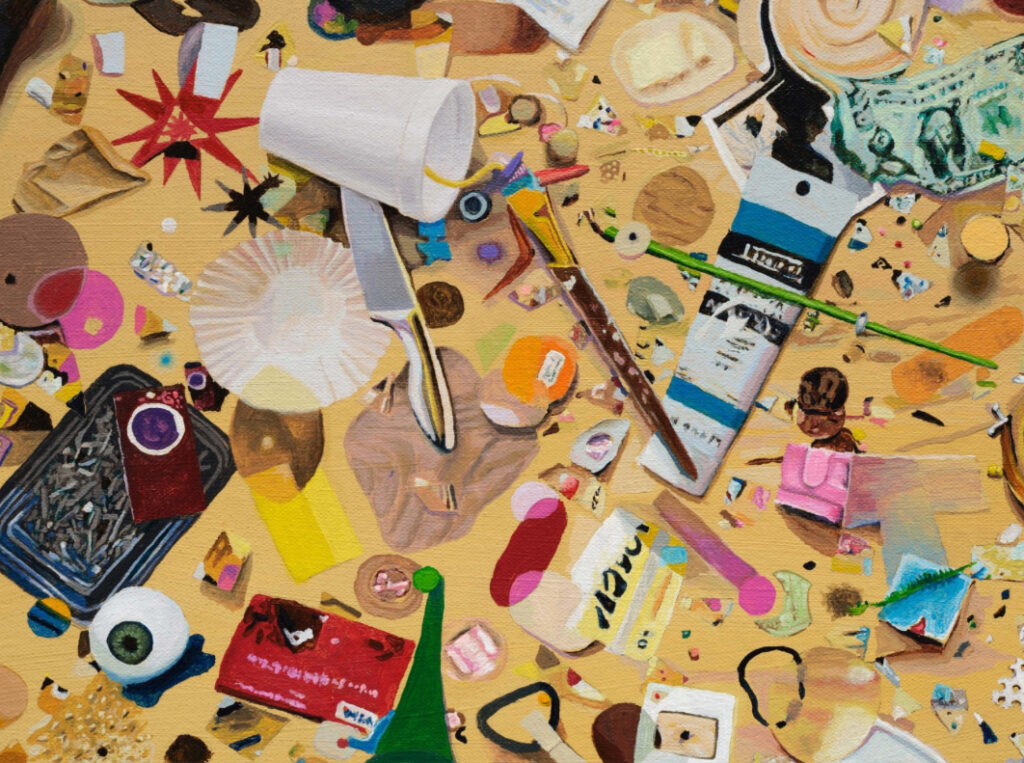When Waste Becomes Warning
In the tangled fabric of contemporary art, where abstraction, irony, and spectacle frequently collide, Tom Friedman’s Detritus, 2025 cuts through like a scalpel. It is not subtle. It is not polite. It does not ask for quiet contemplation—it demands confrontation. What appears, at first glance, to be a chaotic collage of visual clutter is in fact an elegantly orchestrated scream—of waste, excess, entropy, and accountability.
Painted in acrylic on canvas, Detritus, 2025 is more than a painting. It is a time capsule, a warning, and a reckoning. With meticulous detail and overwhelming composition, Friedman captures the messy, material legacy of late-stage capitalism: fragments of logos, facsimiles of packaging, simulations of corroded metal, melted plastic, and disposable design.
This editorial offers a comprehensive examination of Detritus, 2025, situating it within Friedman’s body of work, the discourse on materiality, and the environmental anxieties of our cultural moment. Through close visual analysis and reference to contemporary theory, we unpack why this piece has become a benchmark in 21st-century art’s response to waste.
The Artist’s Evolution: Tom Friedman and the Language of Refuse
Tom Friedman, born in 1965, has long operated on the strange and fascinating border between the sacred and the disposable. His oeuvre spans three decades, encompassing sculpture, installation, drawing, and painting. And yet, throughout these mediums, a consistent voice emerges—one fascinated with the overlooked, the discarded, and the immaterial rituals of contemporary life.
Friedman’s early career was defined by obsessive, even ritualistic labor. In Untitled (A Curse) (1992), he painstakingly shredded personal drawings and placed the fragments on a pedestal, suggesting both the destruction of meaning and the sanctity of artistic material. In 1000 Hours of Staring (1992–97), he literally stared at a blank sheet of paper for a thousand hours. These acts challenge our notions of value: is it in the object, the labor, or the concept?
Fast forward to Detritus, 2025, and we find Friedman’s inquiries matured and intensified. His once playful irony now gives way to urgency. His once private rituals have exploded into public critique. The trash is no longer metaphor—it’s material.
Curator Laura Hoptman has argued that Friedman “turns the banal into the revelatory, asking us not just to look, but to see.” With Detritus, 2025, that imperative feels more vital than ever. The artist’s shift from personal exploration to collective indictment reflects a broader movement in contemporary art—from introspection to intervention.
Formal Analysis: Chaos with a Conscience
The power of Detritus, 2025 lies in its form. The painting overwhelms the senses. Layers of simulated refuse, painted with photographic precision, tumble across the canvas. Yet beneath the apparent disarray lies a tightly controlled system.
Color and Composition
Friedman’s palette is both garish and decaying. Bright, almost fluorescent yellows and pinks evoke plastic toys and supermarket packaging. In contrast, earthy browns and rust-like oranges conjure oxidation and decomposition. The visual result is discomforting—an uneasy collision of the synthetic and the organic.
The composition is dense but not random. Friedman carefully balances clusters of imagery against pockets of space. These negative zones function like silent witnesses, emphasizing the voids left by vanished objects. As critic John Yau observes, “These spaces are not empty; they throb with the echo of what was discarded.”
Illusion and Texture
One of Friedman’s signature techniques is the trompe-l’oeil illusion of real texture. He does not collage real trash onto the canvas; he paints trash so convincingly it might fool the viewer. In Detritus, 2025, plastic crinkles appear palpable. Metal scraps seem to glint. The viewer is invited to mentally “touch” each item—and in doing so, confront their own familiarity with such debris.
Friedman’s choice of acrylic, a plastic-based paint, is itself a statement. The medium mirrors the artificiality of the subject matter. What better material to paint plastic than plastic?
Materiality and Meaning: Waste as the New Iconography
Modern art has always wrestled with materiality—from Duchamp’s readymades to the industrial minimalism of Donald Judd. But Detritus, 2025 belongs to a different genealogy: one that sees trash not as transgressive or ironic, but as historical. The work is not just made of waste—it’s about the systems that produce waste.
The Aesthetics of Excess
Friedman’s work aligns with what some theorists call “garbology aesthetics”—art that explores the life cycle of objects beyond their use-value. In this sense, Detritus, 2025 sits alongside works by artists like El Anatsui (recycled bottle caps), Subodh Gupta (kitchenware sculptures), and Tara Donovan (plastic cup installations). Each of these artists uses mass-produced, disposable objects to interrogate global systems of consumption.
Yet Friedman’s approach is distinct in its simulation. He doesn’t repurpose trash—he repaints it. This distancing effect encourages contemplation. We’re not looking at “actual” trash, but our relationship to it. It’s not a pile; it’s a portrait.
Temporal Paradox: Preserving the Perishable
Acrylic paint is designed to last. Most plastics, ironically, degrade more slowly than many traditional materials. But in Detritus, 2025, Friedman flips that dynamic: he uses a long-lasting medium to mimic the short-lived. The objects he portrays—wrappers, containers, fragments—are meant to be thrown away. In capturing them on canvas, he enshrines them.
This temporal tension recalls Andy Warhol’s soup cans and Brillo boxes, but where Warhol celebrated reproducibility, Friedman laments disposability. His work isn’t pop—it’s post-pop dystopia.
Environmental and Socio-Political Subtext
While Detritus, 2025 functions as visual art, it also operates as environmental critique. Set just slightly in the future, the painting positions itself not as commentary, but as forecast. It imagines a world only marginally worse than our own—a world defined by unrelenting accumulation.
The Anthropocene Canvas
Geologists and cultural theorists now refer to the Anthropocene: an epoch defined by human impact on the planet. Detritus, 2025 can be read as an Anthropocene artifact. It shows not landscapes, but wastescapes. It replaces the sublime with the synthetic. Mountains are now mounds of garbage. Rivers are runoff.
Art historian Julia Bryan-Wilson notes that such works reflect an “Anthropocene sublime,” where the grandeur of nature has been replaced by the terrifying vastness of human waste. Friedman’s canvas, in this light, becomes both map and mirror.
Invisible Labor
There is also a class narrative embedded in the work. Trash is not neutral. It is both symptom and cause of inequality. The production of disposable goods relies on cheap labor; the removal of waste relies on invisible workers. Friedman’s painstaking imitation of refuse pays tribute to these unseen systems.
As media theorist Hito Steyerl writes in her essay Duty-Free Art, “In a culture that disavows its detritus, the artist’s role is not just to recycle, but to witness.” Friedman does exactly that—his canvas is not sanitized. It is haunted.
Reception and Legacy: Beyond the White Cube
Since its unveiling at the 2025 Venice Biennale, Detritus, 2025 has garnered significant attention—and controversy. The painting was acquired by major institutions but also criticized for “aestheticizing apocalypse.” Yet its cultural reach suggests a deeper resonance.
Public Discourse
Reviews have ranged from reverent to skeptical. The Guardian dubbed it “the Guernica of garbage,” praising its moral urgency. ArtNet, by contrast, labeled it “Instagrammable eco-anxiety.” But both agreed on its visibility. Few paintings in recent years have captured such broad attention.
The work also entered environmental discourse. It was cited in a United Nations cultural briefing on the role of art in sustainable development. Though art cannot legislate, Detritus, 2025 proves it can puncture political apathy.
Digital and Meme Culture
Online, Detritus, 2025 has taken on a life of its own. Cropped sections of the painting have become viral images, repurposed in memes critiquing corporate greenwashing. Ironically, the work has been “consumed” by the very culture it critiques—flattened into content.
Yet this speaks to its accessibility. Despite its conceptual rigor, the painting is visually legible. Viewers don’t need an MFA to recognize the objects Friedman depicts—or to feel indicted by them.
A Monument to What We Discard
Detritus, 2025 is not an easy painting. It does not offer hope. It does not offer escape. Instead, it gives us the gift of unflinching clarity. In an age that moves at the speed of swipes and shipments, Friedman asks us to pause. To look. To see.
The painting is a document of this moment—not in its grandeur, but in its decay. It does not claim to fix what is broken. But it makes us stare into the brokenness. And that, perhaps, is its radical gesture.
In an interview shortly before the Biennale, Friedman remarked:
“I don’t think art should be clean. Life isn’t. I want people to feel a little sick when they look at my work—because maybe that’s the only honest emotion left.”
Detritus, 2025 may not clean up the mess. But it catalogs it. It aestheticizes it. And it reminds us that what we throw away never really goes away.
No comments yet.








